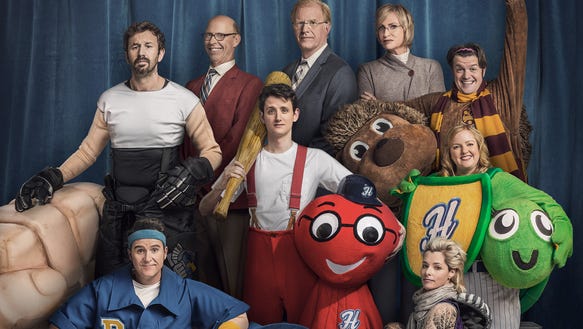With films such as “A Mighty Wind” and “Best in Show,” actor/director
Christopher Guest perfected the mockumentary genre. Since then, television
programs like “The Office” and “Modern Family” have utilized this format as a
style rather than a conceit, and what used to be a novel presentation for
comedy is now a utilitarian way of handling exposition and plot. With Guest’s
latest, a direct-to-Netflix project called “Mascots,” he returns to his
blissfully ignorant weirdo character archetypes and the niche lifestyles that
defined his earlier work. In fact, the film is so firmly designed for this
director that it lacks of sense of purpose or comedic drive, occasionally
drifting into the waters of self-parody.
Here Guest takes a winking jab at the world of sports
mascots who annually compete for an award called the Fluffy at a convention
center in Anaheim. Zach Woods and Sarah Baker play an over-counseled married
couple on the verge of collapse, also doubling as a Squid and Turtle mascot
duo. Tom Bennet plays the nice-but-clueless Owen Golly Jr, who’s taken on the
family mantel as a Soccer playing Hedgehog. Parker Posey plays the
head-in-clouds Cindy Babineaux, competing as a modern-dancing Armadillo.
Christopher Moynihan plays perfectionist Phil Mayhew (aka Jack the Plummer) and
Chris O’Dowd plays Irish bad-boy Tommy Zucarello, a Hockey mascot called ‘The
Fist’ who’s been banned from many sports venues for his edgy entertainment
style. As one would expect, egos clash and misunderstandings are had at the
SoCal convention.
Because Guest’s style encourages and depends on seamless
improvisation from his actors, scenes live and die on their performances. The
cast is committed to the challenge and they’re all appropriately on the same
page, but they’re also too similarly pitched to really distinguish themselves
amongst each other in any given scenario. The jokes and one-liners often fall
flat or feel forced and the improvised dialogue usually leans on the easiest
laugh. The film spends too much of its run-time establishing the characters and
their motivations, and once the plot foundation is finally set into place the
whole narrative is already winding down to a no-surprises conclusion.
There’s an infectious warmth for this dorky profession and the
peripheral performances from Fred Willard, Jane Lynch and Christopher Guest
himself—reprising his role as acting-coach Corky St. Clair from 1996’s “Waiting
for Guffmam”—infuses this lazy comedy with some genuinely off-beat moments, but
the movie’s best sequences come from the well-staged competition routines by
the mascots themselves. There’s something oddly cinematic about watching a
well-rehearsed physical act and these scenes are competently shot and
dramatically informed.
“Mascots” isn’t entirely painful to watch but considering
the talent involved in its making, it is painfully ordinary. Perhaps the glut
of mockumentary alt-sitcoms such as “Parks and Recreation” have familiarized us
with this genre to the point of making it obsolete, and perhaps in our current
economic reality the concept of making fun of clueless, low-earning middle
Americans who have aspirations for something bigger now registers as tone-deaf.
Whatever the problem, something here never here gels comedically and the movie
radiates with a sense of Guest and his crew coasting on their reputation.
Grade: C+.
Originally Published in the Idaho State Journal/Oct-2016
Listen to this week's episode of Jabber and the Drone to hear more conversation about "Mascots."






